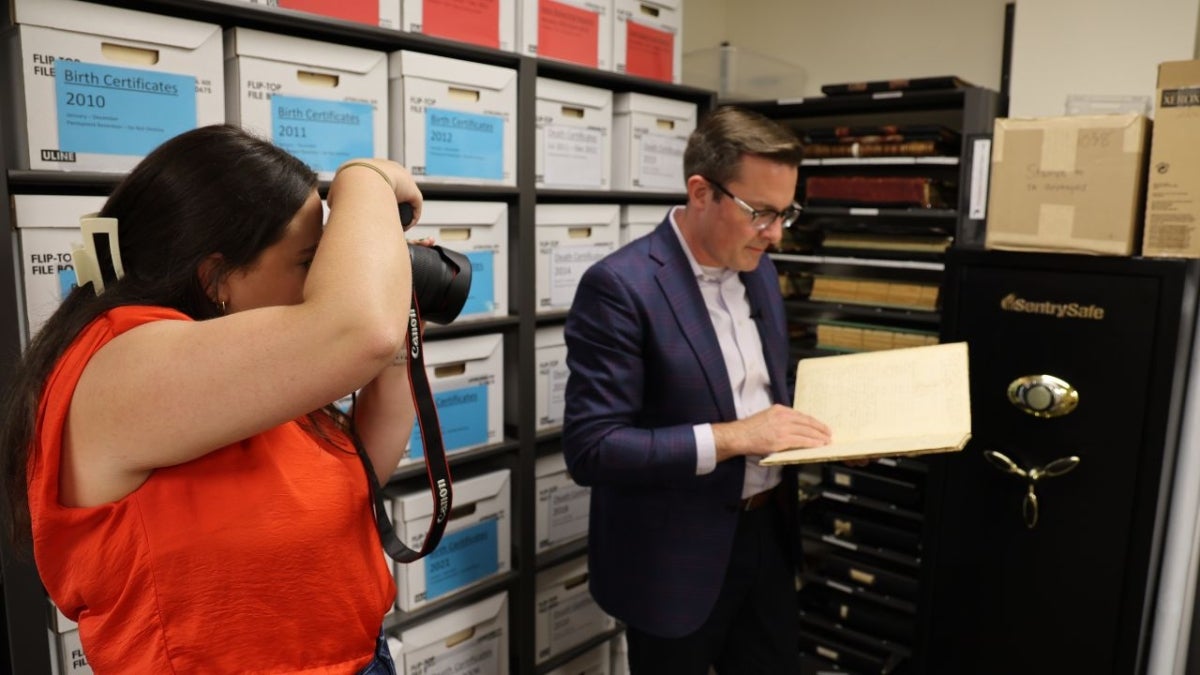The times — and the paper — have changed a lot in six decades, but the experience of helming the State Press is as rewarding now as it was 60 years ago, agreed the news men and women gathered for an editors reunion luncheon hosted by the Arizona State University Alumni Association.
The oldest editors in the room came from the days of print afternoon editions, pulling wet-ink copies off the press and laying papers out on a stone.
The youngest editors publish editions that will never exist on paper, cover multiple campuses instead of one and run dual newsrooms.
What has never changed is the stress and rewards of putting out a paper five days a week, and the camaraderie of slaving to learn the craft in a gloomy basement full of junk and steel desks. Editors, reporters and photographers from across the country and globe grew up in that basement, going off to wire services, metropolitan dailies and small-town weeklies.
“I fell in love with newspapering,” Don Dedera, editor in 1951 (pictured above fist-bumping Sparky), said of his experience. “We used to put it out on Mill Avenue at the Tempe Daily News. A lot of it was self-hypnosis, but we thought it was a calling. We were like a priesthood.”
Dedera went on to become the Arizona Republic’s star columnist, the editor of Arizona Highways (“It very nearly killed me, but I enjoyed it”), and the author of 26 books and more than 6,000 articles. He is most noted for a series of columns he wrote in 1960 that led to the parole of the Power brothers, two men wrongfully imprisoned for more than 40 years after the deadliest gun battle in state history. ASU Archives and Special Collections has his papers in Hayden Library.
Dedera’s most significant contribution to State Press history was taking it from a weekly to a biweekly.
“You know how we did that?” he said. “We doubled cigarette advertising. When I went to school here, everyone smoked, in class and out, including the professors. You just about choked to death. No one was about to tell these veterans whether they could smoke or not. They’d just come back from kicking Hitler’s ass.”

ASU President Michael Crow greets ASU alumnus and former editor-in-chief Don Dedera during a State Press reunion of editors at Old Main on April 13.
Photos by Deanna Dent/ASU Now
“Some of the thinking wasn’t so great, and some of the writing was awful,” reflected Jay Heiler, editor-in-chief from fall 1982 to spring 1983, now chair of the Arizona Board of Regents and founder and board president of Great Heart Academies. “It has to be one of the best formative experiences for any student at any university.”
Heiler described putting out a daily paper and “feeling the weight of institutional responsibility.”
“The process of producing a daily newspaper has infinite value in the formation of a student,” he said, calling the Press “an always-lively source of news and commentary.”
Ray Stern was editor-in-chief in fall 1997. Stern is a veteran reporter at the Phoenix New Times who has won the state’s top investigative journalism award and a slew of other recognitions, as well as being named blogger of the year for the past five years.
“The State Press was instrumental to my career,” Stern said. “It brought me real-world exposure — trial by fire. I encourage every student journalist I talk to to at least freelance there, if not work there.”
Stern called it a better place to make mistakes than reporting professionally in the real world. “As a student, you need that cushion,” he said.
Another favorite memory for Stern: “the ambience too — down in the basement.”
Shelby Slade, class of 2016 and the current editor-in-chief, said the mission remains the same: “a news source that keeps students informed and the university accountable.”
The problems remain somewhat the same, Slade said, “trying to balance quantity with quality.”
“We still have sketchy sources and flaky reporters,” she said.
Covering four campuses and using metrics to measure performance are new challenges.
The State Press is “where I’ve had some of my favorite college memories,” said Slade, speaking for everyone in the room. “Yes, the basement is crusty, and it doesn’t get a lot of sun.”
“I’ll leave knowing I did something that mattered,” Slade said.
Seckel, the writer of this story, was a State Press reporter from 1987-1990.
More Law, journalism and politics

Native Vote works to ensure the right to vote for Arizona's Native Americans
The Navajo Nation is in a remote area of northeastern Arizona, far away from the hustle of urban life. The 27,400-acre reservation is home to the Canyon de Chelly National Monument and…

New report documents Latinos’ critical roles in AI
According to a new report that traces the important role Latinos are playing in the growth of artificial intelligence technology across the country, Latinos are early adopters of AI.The 2024 Latino…

ASU's Carnegie-Knight News21 project examines the state of American democracy
In the latest project of Carnegie-Knight News21, a national reporting initiative and fellowship headquartered at Arizona State University’s Walter Cronkite School of Journalism and Mass Communication…
